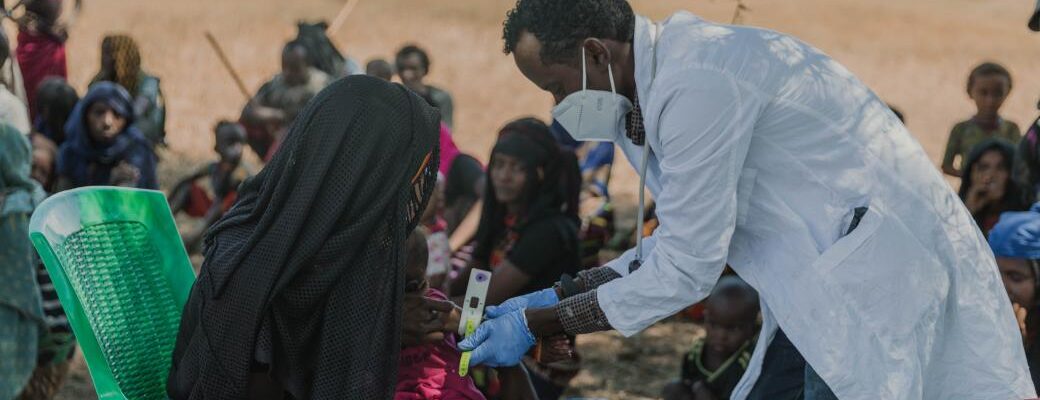CERF responds to food insecurity and malnutrition for very vulnerable communities
Vanuatu, Ethiopia, Yemen and others| 2023 | CERF
Ethiopia, Vanuatu, Yemen and others. As food prices continue to rise worldwide, the Central Emergency Response Fund is at the forefront of helping emergency-affected people get food assistance and cash; to improve their kitchen garden food production and agricultural livelihoods after disasters; and prevent the worst effects of malnutrition.
Mobile health and nutrition teams in Ethiopia
Temira, mother to one-year-old Zahara, has brought her daughter to a mobile outreach health site near her home in Chifra, Afar, in north-eastern Ethiopia, for vaccination and a check-up.
Ethiopia has now suffered five seasons of failed rains and over 24 million people face food insecurity. Most of the drought-affected people are nomadic pastoralists who need assistance just to survive. This number has nearly tripled since the first half of 2022.
Deep in the remote drought-gripped areas of Ethiopia, mobile teams, with World Health Organization (WHO) support and funding from CERF and other donors, are working to deliver critical health assistance and malnutrition treatment. This saves lives, especially among children for whom the combination of malnutrition and disease can be fatal.
“This clinic is near my home, so I can easily bring Zahara,” she says. “When I am not feeling well, I also receive health services here.”
Nurse Ahmed Amin attends to Zahara and measures her arm using a mid-upper arm circumference measuring tape, a critical tool used to screen children for acute malnutrition. “I observe children here up to the age of five years and I conduct nutrition screenings,” explains Ahmed.
“I am very happy to be part of this mobile health team because this location is quite remote. Were it not for this team, people would not have easy access to health care,” says Ahmed.
Cyclone-affected people restore their home gardens in Vanuatu
Jane Sola, a farmer in Teuma, Port Vila, has been affected by two cyclones this year. In an unprecedented occurrence this year, Vanuatu experienced the wrath of Tropical Cyclone Judy, immediately followed by Tropical Cyclone Kevin just days later. This rapid succession of cyclones magnified the devastation inflicted upon the island nation, exacerbating the already significant damage caused by the initial storm.
With CERF and other funding, FAO worked to distribute critical seeds to affected areas. Ms. Sola and others were able to re-sow and grow food in their home gardens. “The backyard gardens have been improved. Tools and seeds provided by FAO have been instrumental in helping us overcome the effects of the two cyclones,” she says.
Reproductive health care for women facing food insecurity
Women and girls in Yemen continue to bear the brunt of the conflict-induced crisis. Yemen has one of the highest maternal death rates in the region, with less than half of births assisted by skilled medical personnel and only one in five of the health facilities that remain, providing maternal and child health services.
Over 1.5 million pregnant and breastfeeding women were projected to experience acute malnutrition in the course of 2023. They risk giving birth to babies with severe stunted growth, and nursing malnourished infants because they themselves aren’t getting enough to eat.
CERF funding helped UNFPA reach 50,000 women and girls in the worst affected Al Hudaydah, Hajjah, and Taizz governorates. Improved reproductive health care can help prevent malnourished babies, and improve women’s access to protection services as well.
Funding helps people around the world
In Syria, UNDP used CERF to support resilient livelihoods for women like Naima, who recently returned to her home village after conflict-related displacement. She received better seeds, an improved irrigation system and the training to use it.
Not only did Naima grow courgettes to feed her family but made a good profit selling the surplus. “We were told there would be some support to cultivate the land. Our previous system was not very good, but now we can do it right,” she explains.
Similarly, CERF funding helped people affected by severe food insecurity in Cameroon with seeds, tools, and livestock.; while CERF helped WFP deliver daily hot meals for people displaced by violence in Haiti’s Carrefour Feuilles and Savane Pistache districts.
Original story: adapted from original articles by FAO in Vanuatu; WHO in Ethiopia; and UNFPA in Yemen
More information about the CERF allocations in Vanuatu, Ethiopia, Yemen and Syria.
